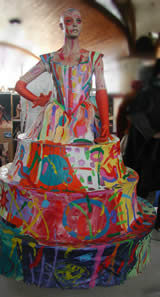 |
 |
 |
|
|
OISTAT's Costume Group
Plans Carnival Trip to Cuba OISTAT, the International Organization of Scenographers, Theatre Architects, and Technologies, is planning a symposium this summer of special interest to costumers. The OISTAT Scenography Commission's Costume Working Group organizes activities that are oriented toward costume. In July 2004, a symposium for OISTAT in Cuba is planned, focusing on Carnival Costume. This symposium is open to all costume designers, scenographers, and related technicians who have an affiliation with OISTAT. This includes members of the individual country organizations who send representatives to OISTAT. USITT is the United States centre for OISTAT. This International Carnival Symposium will be held at the far eastern end of Cuba in Santiago. Santiago de Cuba is well known for its Carnival, happening around July 26 each year. July 26, 1953 is generally regarded as the date when the Cuban Revolution began. When Fidel Castro took over, one of his earliest actions was to change the religious holiday of Carnival to a summer event commemorating the Revolution. Most businesses shut down for the 10 days surrounding Carnival. In Santiago de Cuba there are eight days of Carnival parades, starting on July 19 and building up to a climax on July 26. The whole Cuba event will last two to three weeks. Since it is difficult to fly directly to Santiago, the group will meet in Havana on July 17, 2004, and there will be a city tour arranged for that day including a study of the Old Havana architecture and museums. On July 18, participants will travel a short distance to Matanzas to see the Sauto Theatre, the Papalote Theatre, and possibly a performance from the Afro-Cuban company, Los Munequitos de Matanzas. That day will also be a partial day of leisure at the beautiful beaches of Varadero before the group takes the night train to Santiago de Cuba. Activities for July 19 through 26 will be centered in Santiago for the symposium and Carnival. There will be a side trip to Trinidad, Cuba during this week to compare its approach to Carnival. On July 27 participants leave Santiago and visit the Camaguey Theatre and Ballet, where Maria Luisa Bernal is the resident designer. Ms. Bernal was one of the honored Cuban guests at USITT's 2002 Annual Conference & Stage Expo in New Orleans, Louisiana. Ms. Bernal won the grand prize this past year for her Carnival parade costume designs inspired by that trip to the United States. On July 28 the group will head back to Havana to explore the Carnival there. Carnival in Havana is planned for August 1 to 10, 2004. The International Carnival Symposium will include presentations from OISTAT members around the world. There are currently talks scheduled about Carnival in the Philippines, Brazil, Panama, and Trinidad. Also planned are talks about Mardi Gras in New Orleans, Mardi Gras and Carnival in Venice, and presentations from Cuban designers in Santiago and Havana. Hilary Baxter of the United Kingdom will talk about Carnival costume as it relates to the Gay Pride Parade in that country. The web site for the Costume Working Group of OISTAT's Scenography Commission is sp.uconn.edu/~lcrow. The program is still in flux. There will be further updates on the website under Events. The non-government national cultural organization of UNEAC (Union of Writers and Artists of Cuba) will issue invitations. It is the organization in charge of cultural exchanges in Cuba. Jose Antonio Prades Hung, Head of the OISTAT Scenography Commission in Cuba, is in charge of arrangements. To receive more information, send name, address, phone number, and e-mail address to Laura.Crow@uconn.edu. The list will be forwarded to Cuba from which an official invitation will be issued. The Cuban OISTAT delegates were all very inspired by their trip to Mardi Gras in New Orleans. It was this trip that reinforced the idea that a symposium centered on Carnival in various parts of the world would be an inspiring event for all designers. Those planning to attend are urged to investigate all angles of travel to Cuba thoroughly because regulations governing citizens of the United States and other countries can vary greatly. Photos courtesy/Laura Crow. |

A Cuba Carnival Queen costume designed by Cuban Jose Limia, "Pepin." 
This carnival costume by Tracey Collins of New Zealand is constructed entirely from paper.
|